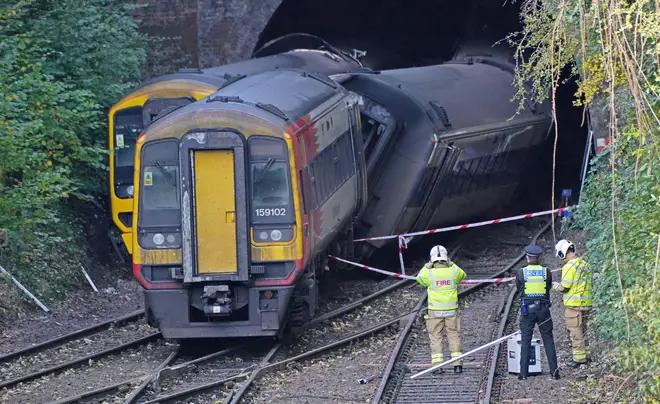
Henry Riley 7pm - 10pm
3 November 2021, 16:14 | Updated: 3 November 2021, 16:15

The train that collided with another in Salisbury on Sunday ran 220 meters past a stop signal, investigators said, despite the train driver attempting to apply the brakes before reaching the signal.
The Rail Accident Investigation Branch (RAIB) said the driver of the South Western Railway (SWR) train tried to apply the brakes but was not able to stop the train from smashing into the side of a Great Western Railway (GWR) service, despite the train's automatic protection system also requesting emergency braking.
The preliminary report said this was due to the SWR train's wheels slipping on the rails.
The RAIB said the collision caused both trains to derail, after which they "continued some distance" into the tunnel before coming to a stop.

The driver of the SWR train, 74-year-old Robin Tandy, suffered "life-changing" injuries in the collision.
He has been described as a "deeply respected colleague" with over 50 years' experience of driving that particular route.
In a statement, SWR said he had made a "valiant attempt to to keep his passengers safe" and welcomed the initial report which found the driver "reacted correctly to the signals by braking to slow the train down".
"While the investigation has a long way to run, these initial findings are helpful to stop speculation and focus attention on the evidence about the likely cause of the collision," said a SWR spokesperson.
"We want to pay tribute to our driver who was injured on Sunday night.
"He is a deeply respected colleague, who has over 50 years' experience of driving on this route and an excellent professional track record.
They added: "Initial findings indicate that the driver acted in an impeccable way in a valiant attempt to keep his passengers safe, staying at the controls throughout.
"We thank him for his actions and we wish him a speedy recovery as he continues to be treated in hospital."

Police continue to work at site of train crash in Salisbury
Low adhesion between train wheels and rails can be particularly severe in the autumn due to leaves falling from the 13 million trees near Britain's rail lines.
A thin, slippery layer is created when trains pass over leaves, which has a similar effect to black ice on roads.
It makes it harder for trains to accelerate and brake effectively, leading to some operators publishing special autumn timetables to allow extra time for trains to be driven more cautiously.
Martin Frobisher, Network Rail's safety and engineering director, said on Tuesday night that the issue "affects railways across the world".
Read more: 13 people taken to hospital after Salisbury train crash
Read more: Salisbury train crash: Driver sustained life-changing injuries, police say
As part of its inquiry, the RAIB will examine how Network Rail managed the risk of "low wheel/rail adhesion" at the site of the incident, as well as considering Network Rail and SWR's general policies towards the issue.
There is no mandatory retirement age for train drivers in Britain.
A driver can keep their licence as long as they pass regular medical and competence assessments.

LBC's West of England correspondent gives update on train crash
A total of thirteen passengers were taken to hospital with minor injuries after the collision.
Emergency services rushed to the scene of the crash, which happened at Fisherton Tunnel just before 6:45pm on Sunday.
The collision - which witnesses have likened to sounding like a "bomb" going off - was declared a major incident soon afterwards.
Tweeting soon after the crash, Transport Secretary Grant Shapps said: "We need to understand how this happened to prevent in the future."
Disruption to services through Salisbury is expected to continue until at least the end of the day on Monday November 8.